The Journey through the Brain: Understanding Anatomy
Author: Neeraj
The project that I am doing is designed to create a way to familiarize yourself with brain anatomy in an easy way. This project aims to introduce students to the major structures of the human brain. Why this topic?Because from high school to university, brain anatomy has been taught in an abstract or overly technical way which can be very intimidating for the new learners. I remember in high school when I took biology, I usually got scared from anatomical chapters due to technicality. My goal is to make the material accessible, memorable and visual by joining science and story telling,
FINAL DESIGN COMING SOON.
THE PROCESS
Phase 1: Understand (Discover, Interpret, Specify)
DESCRIBE THE CHALLENGE:
Students in high school and university often struggle to understand the brain anatomy due to the material being so abstract, terminology heavy and lacking engaging examples.
CONTEXT AND AUDIENCE:
Typical Audience: University students, age ranging from 18-25, who are currently in high school and university students from psychology and biology who are learning the brain anatomy for the first time. In the extreme audience comes high school students who took basic neuroscience and adult learners who need simplified but very accurate explanations. This comic will also target the audience who uses digital learning tools and enjoys comic infographics. Students learning brain anatomy are often faced with information overload. The brain has many parts, each with technical names and functions, resulting in the result of memorizing them without context feels abstract. Learners need the resources that break down the technical information into manageable chunks by using simple analogies and showing clear visual connections between structure and function.
Needs/Goals/motivations:
- Provide clear visuals + analogies to connect structure with function
- Show how neurons communicate in an easy way
- Simplify brain anatomy into manageable chunks.
- Encourage long term retention.
- Motivated by everyday examples such as sports that ties brain parts to everyday life.
POV STATEMENT:
New university students need an engaging, visual way to understand brain anatomy so that they can connect complex terms with real world functions and remember them for their academic gain.
LEARNING OBJECTS:
- Identify the four lobes of the brain and their primary functions.
- Role of cerebellum and brainstem in motor control and survival.
- Function of deeper structures such as hippocampus and amygdala.
- How neurons communicate and create networks.
- Reducing stress and anxiety around learning complex anatomy.
- Make an easy approach for beginners to learn brain anatomy
Plan (Ideate, Sketch, Elaborate)
IDEATION:
I have wondered through various ideas on how to start this project. The process began by identifying the key brain structures most important for beginners, including the frontal lobe, temporal lobe, occipital lobe, parietal lobe, cerebellum, brainstem, hippocampus, and amygdala. These are the ones that I decided to go through with. I have explored various metaphors through which I can explain the anatomy in an easy-to-understand way, such as a brain cartoon character teaching a confused student about the functionality of different brain parts. Another metaphor that I tried was a workplace or office map where the manager would be the frontal lobe, the coach would be the cerebellum, and so on.
The one I decided to go with is going to be 12-18 panels. This is going to be a conversation in a storytelling format between the brain cartoon character and the student who was stressed about learning the anatomy of the brain.
STORYBOARD OR SCRIPT:
The script starts with a confused student unable to learn brain anatomy, and then a brain cartoon character appears to teach him its functions, where he will give a tour around the various brain structures and their functions. The comic will contain about 16 – 20 panels in total. Below is the first page containing nine panels. Please note it’s the rough sketch, not the final.
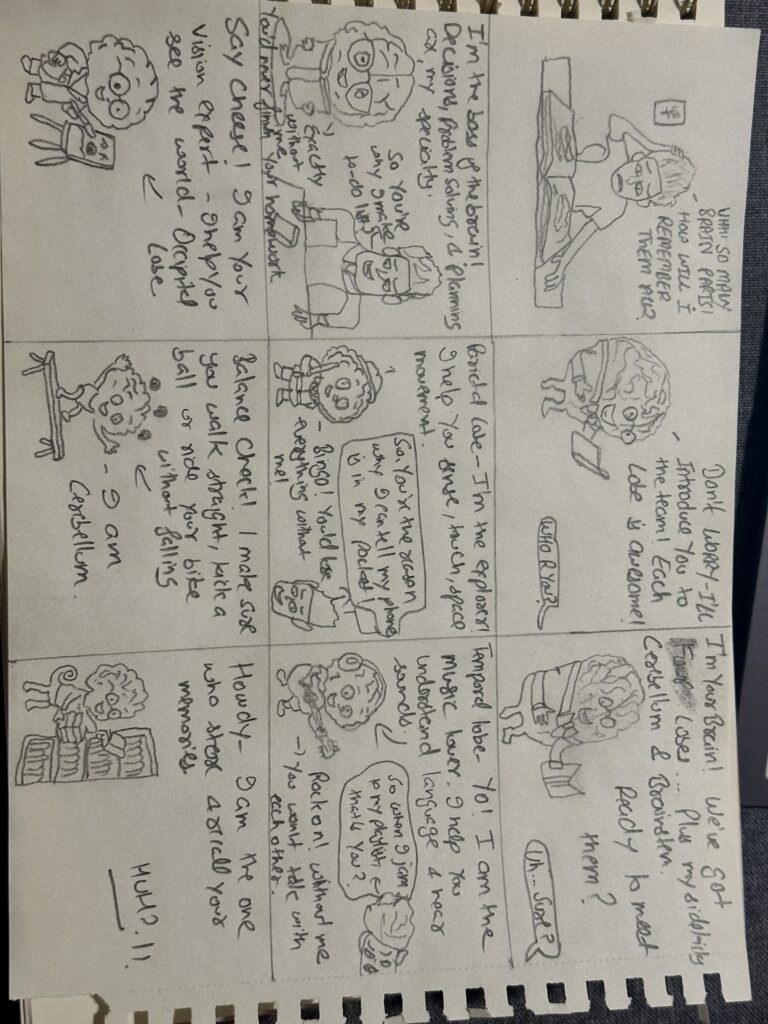
PRINCIPLES APPLIED:
In this project I have used several of Mayer’s principles of multimedia learning to make content more engaging, accessible and educationally effective. Firstly, the Coherence principle guided me to eliminate distracting details to avoid cognitive overload and only focus on essential brain structures such as lobes, hippocampus, amygdala and brainstem. I also used the Signaling Principle through consistent color coding and labels for each lobe and structure, while speech bubbles and narration boxes directed the focus on the main idea on each panel.
The project also uses Modality Principle by balancing visuals and text instead focusing heavily on dense narration which allows learned to process information through both visual and verbal channels. The story will take the reader through the city of the brain, explaining the functions of each main structure like riding a bicycle through a new city. Finally, the Redundancy principle will be in use by avoiding duplicate information to be narrated but instead each medium compliments each other.
Prototype and Final Version
Prototype
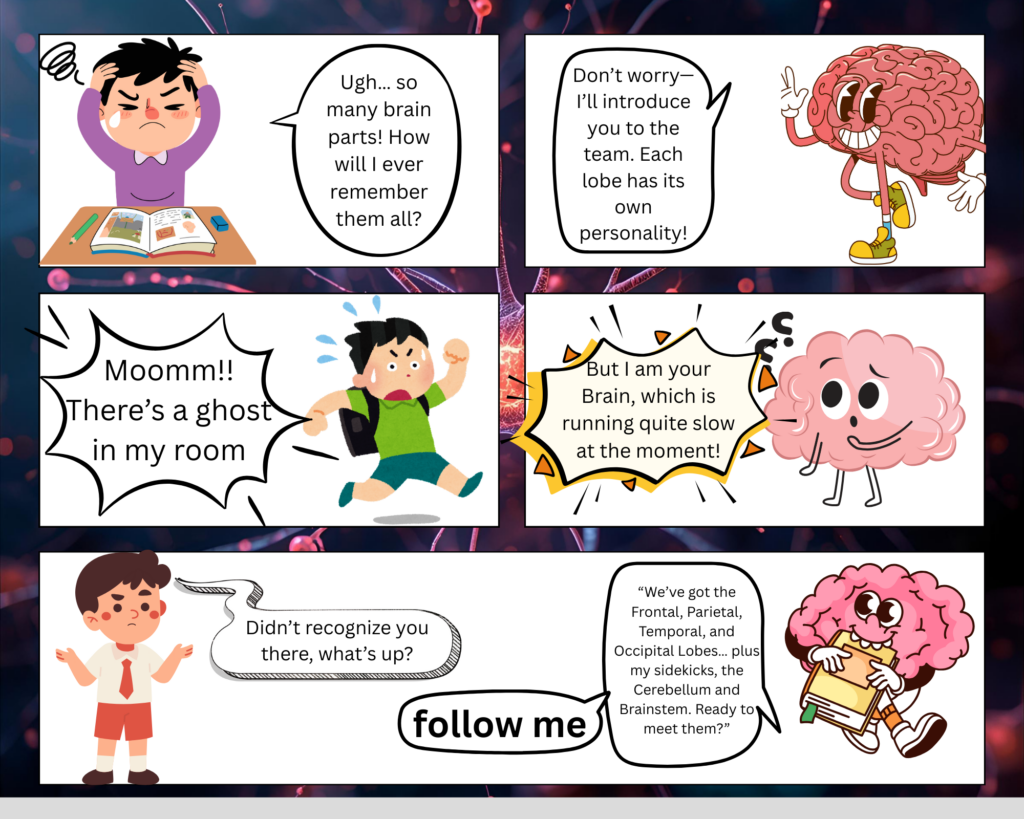
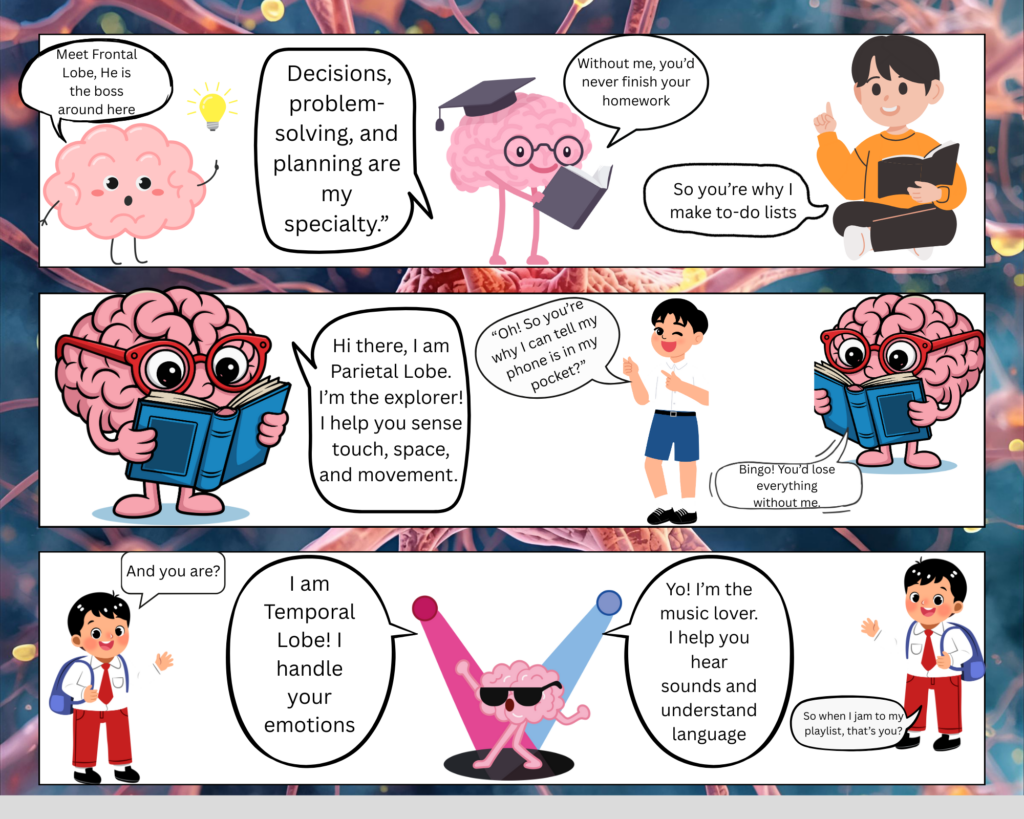
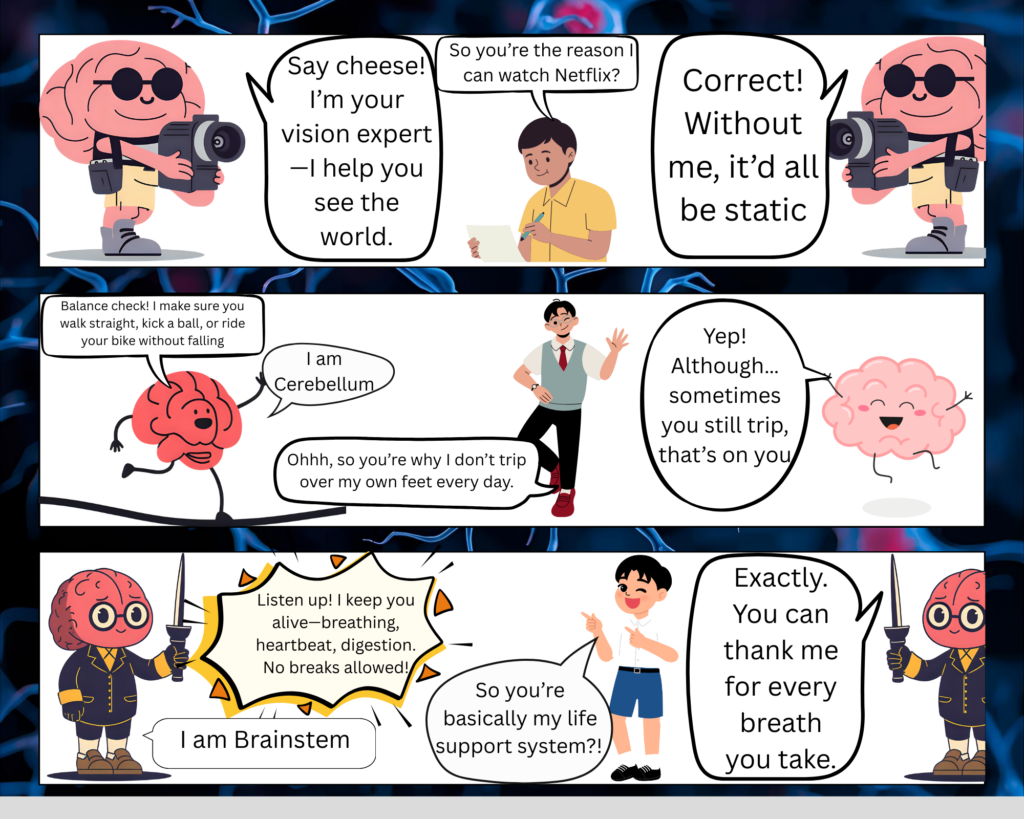
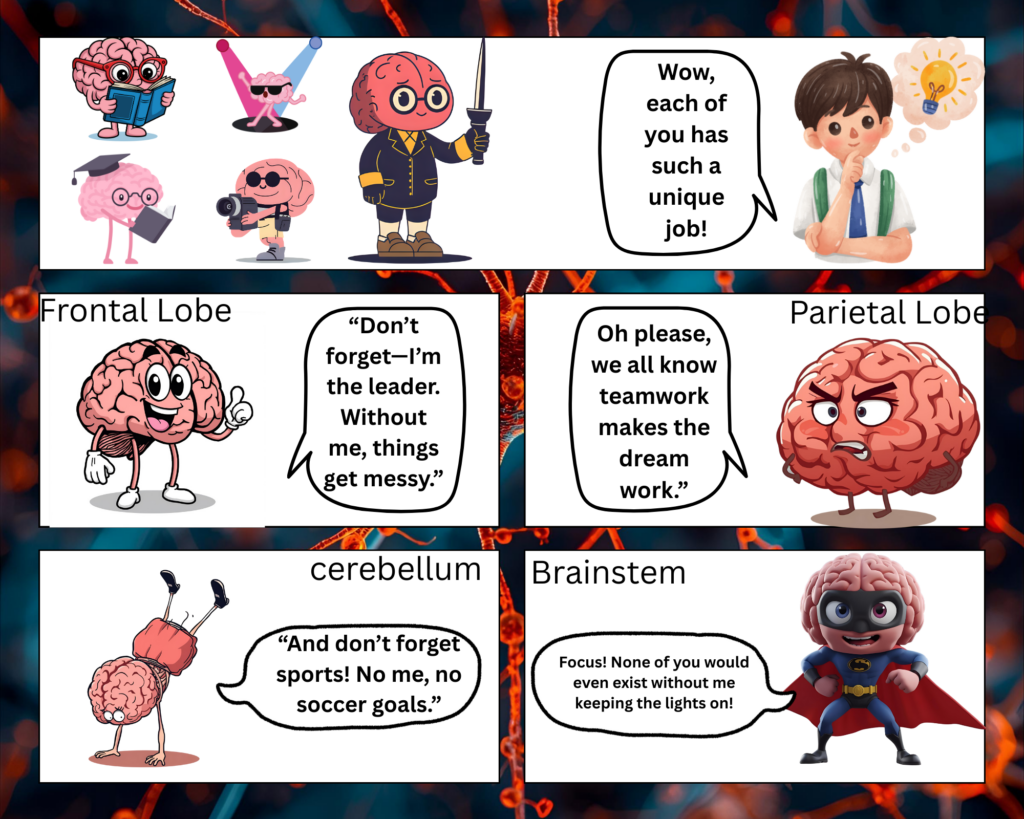
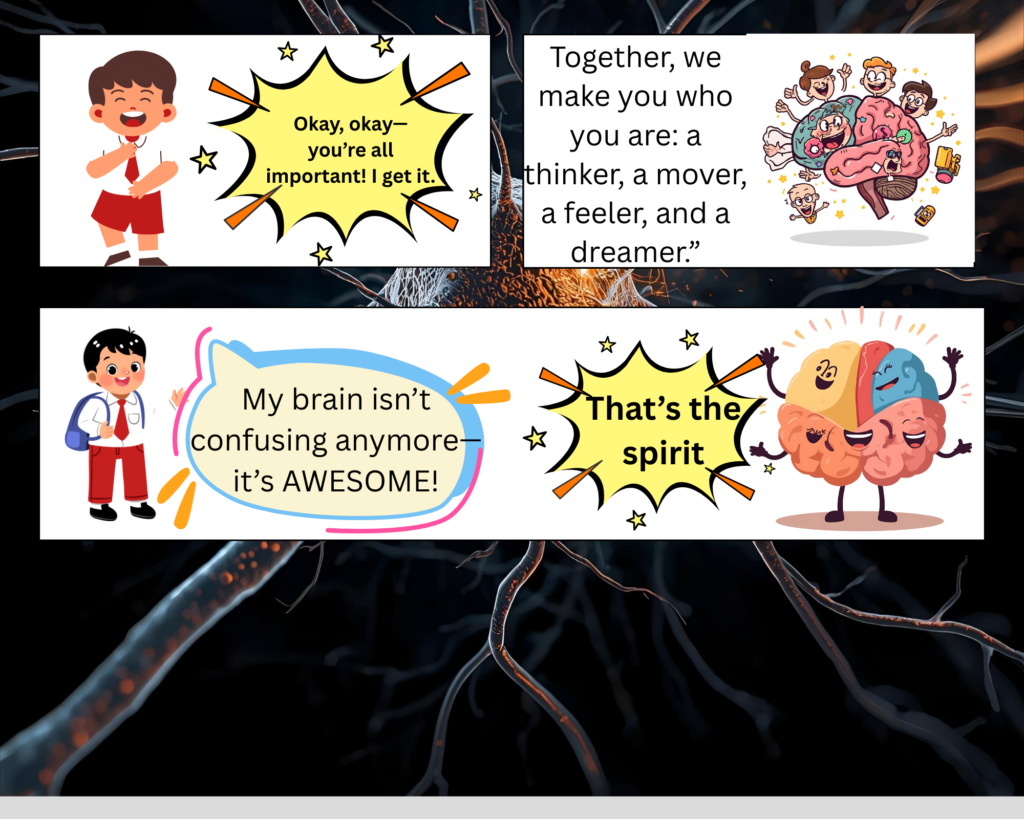
Final Version – Comic
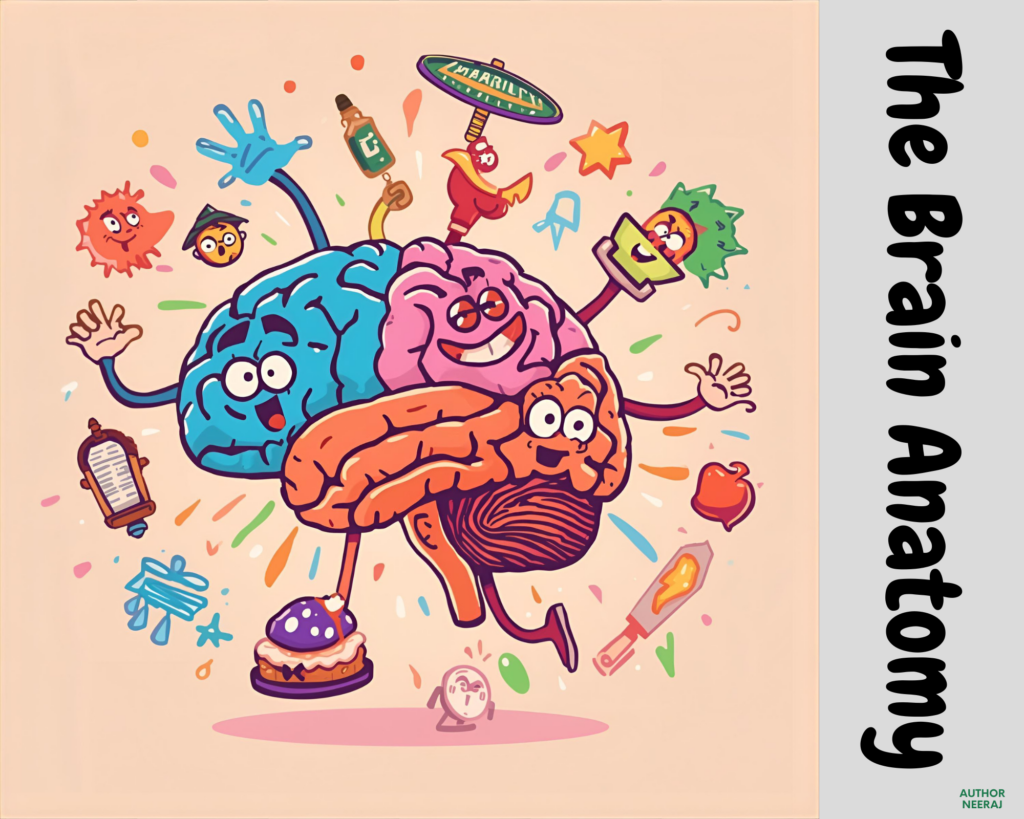
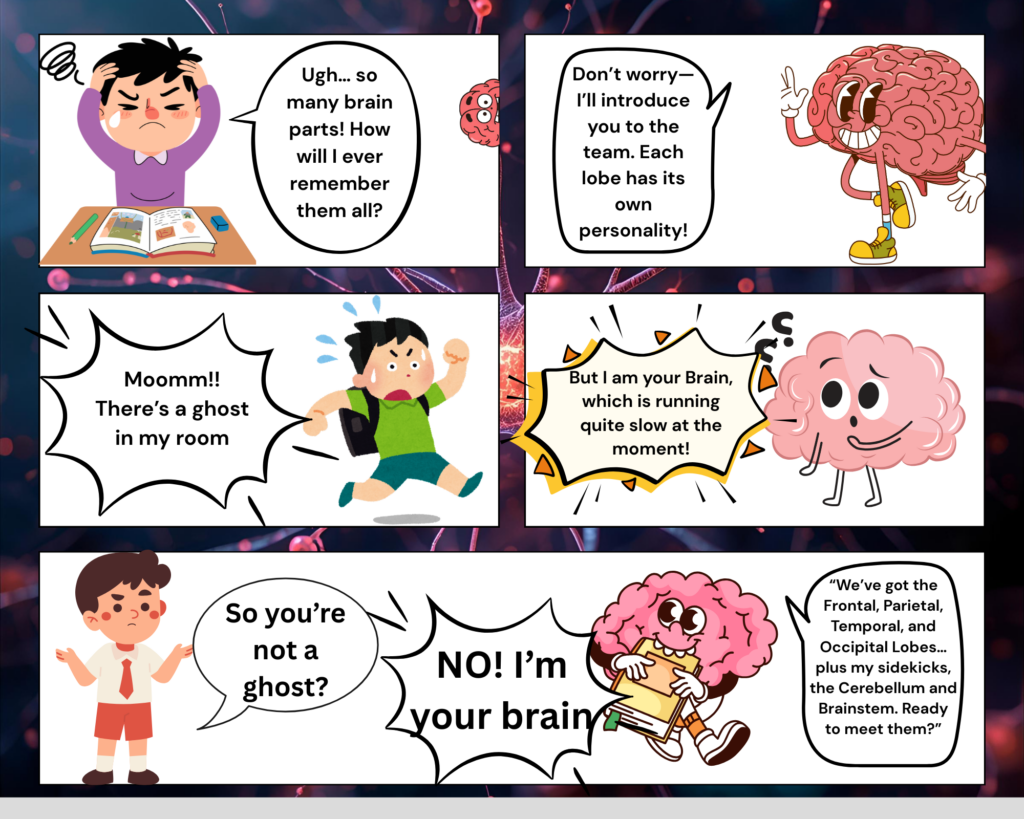
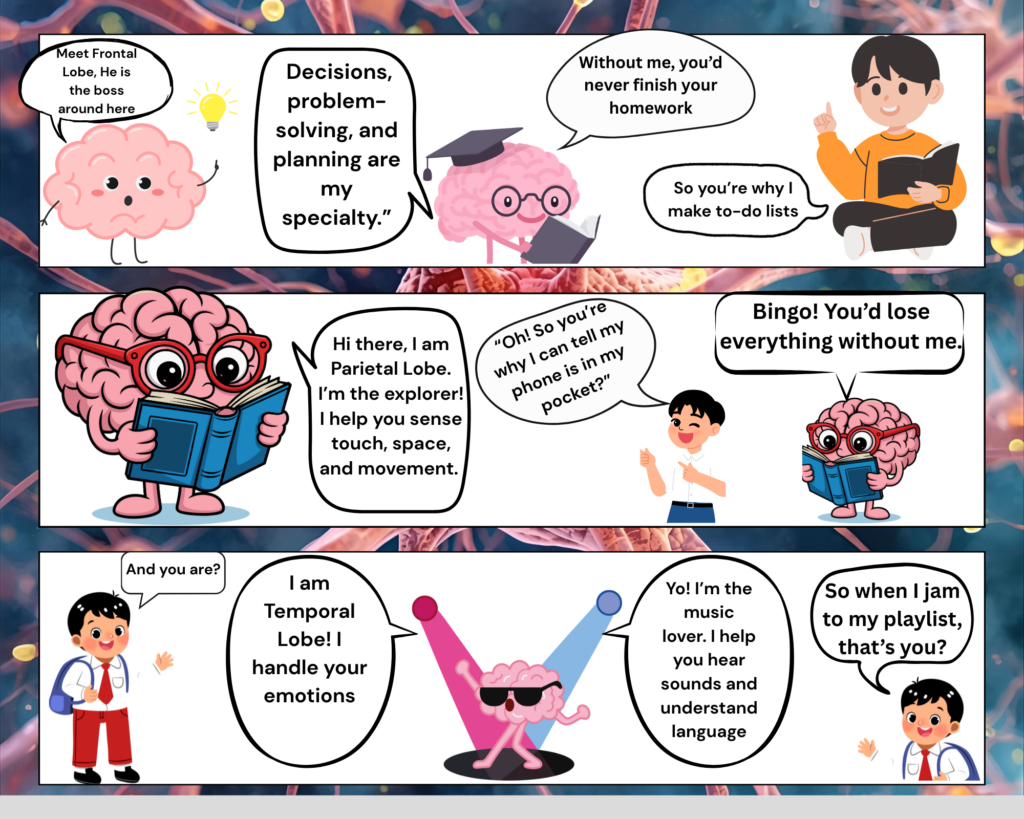
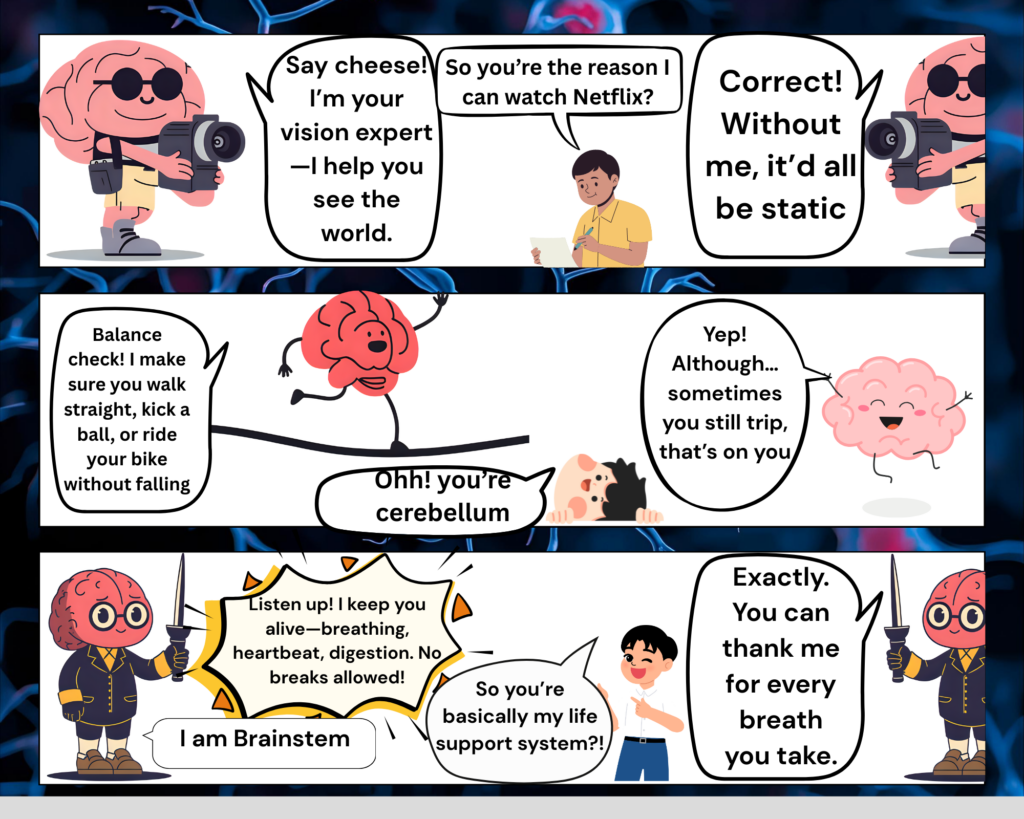
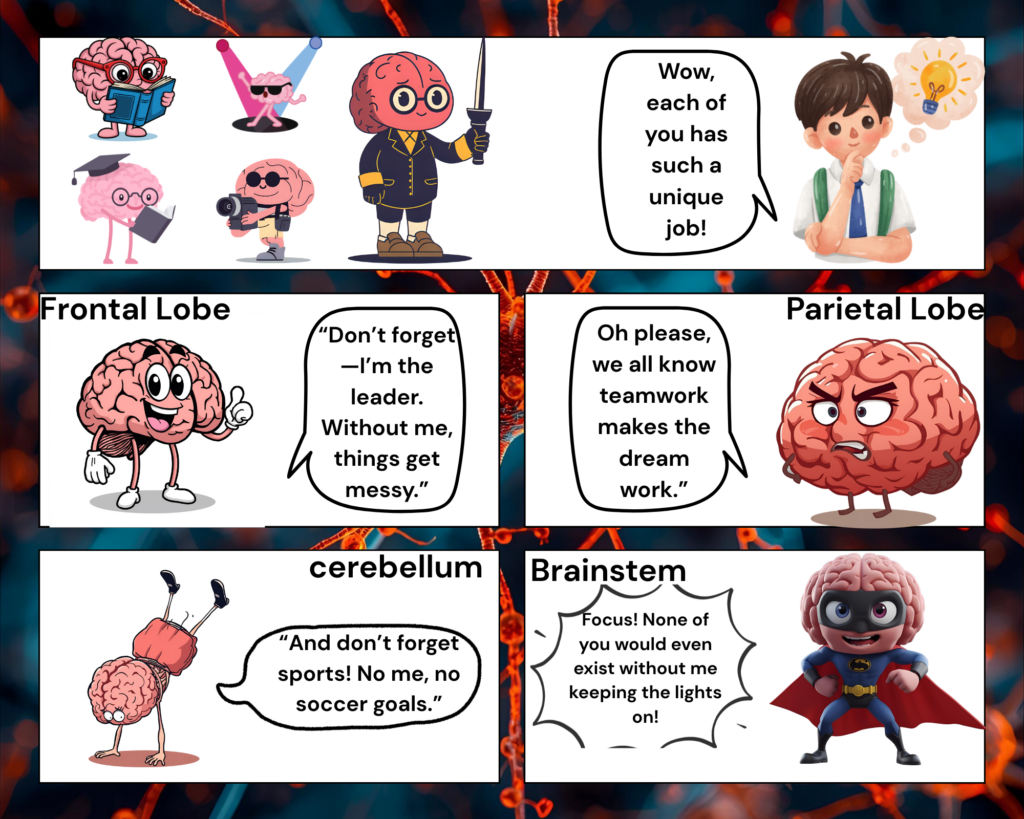
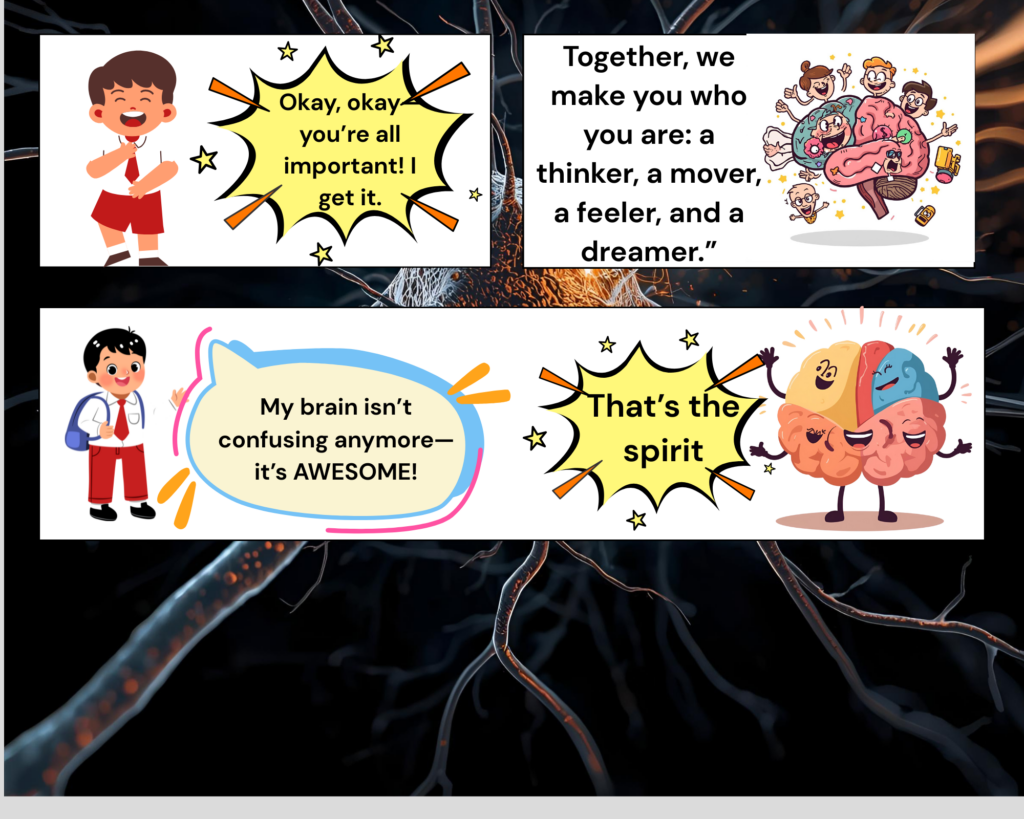
Peer Feedback
My peers helped me to see the learner’s perspective regarding my comic through their feedback. Both of my peers stated that the use of characters representing each brain part individually made it a lot easier to understand the brain parts and their functions. They also made comics more engaging and fun to read. I also received positive feedback about visuals and text being used. It was balanced with not too many arts and colors at the same time the text was very clear to the point. These comments about my prototype made my goal of teaching brain anatomy in a less technical way and more engaging seems to be successful.
There were some areas for improvement as well, which were highlighted by my peers. One of them commented that the beginning of the storyline seems to be confusing; it did not transition well into the story further. My store line is a frustrated student trying to learn brain anatomy, who is then guided by the brain character. I understood that I needed to create a smooth storyline with panels to get the best transition into the later story. Another peer highlighted the use of the term brain city which showed the lack of clarity with the storyline and can lead to misinterpretation. This comment made me realize that learners need clear context and narrative flow to learn more efficiently.
Reflect and Refine
The feedback that I received confirmed the use of cartoon characters, examples related to their function and clear text for creating clarity and engaging in my comic. It also taught me the importance of narrative flow in an educational design to make it engaging. My idea was to take a brain cartoon character to teach the frustrated student about its structure and functions but as per feedback the lack of clarity in introduction led to confusion. It made me understand that learners need accurate information with clear framing and transition to guide them through the material. The feedback also made me reflect on my learning goals because it is impossible for me to include every detail in my comic without creating cognitive overload with a load of information so I have to be realistic and align my goals with what the comic actually teaches.
For revision, I started by adding a stronger and clearer introduction, setting up the premise of the frustrated student and the brain cartoon character stepping in as the teacher. It eliminated the initial confusion and made a strong base for a better transition into the later storyline. I also revisited my goals to focus on individual lobes and their everyday functions, making sure that they are aligned with my goals and content. These refinements aim to keep the comic learner-friendly while making sure that the design is aligned with educational purposes.
Multimedia Artifact Prototype
My multimedia artifact prototype is in the form of a comic where a student is very frustrated due to his inability to learn brain anatomy due to technical terms and then a friendly brain cartoon character pops up and gives a guided tour to the student of the brain and its functions. Thai design combined the visuals, text and characters with individual personality to make it more engaging. Each panel of the comic introduced one concept individually such as frontal lobe, temporal lobe, using short conversations and clear information to reduce the cognitive load. The brain cartoon character uses gestures, activities and symbols to make it very easy for the student to understand everyday functions of each lobe. These expressions, cues and colors focused on the main ideas that i wanted to relay which supports Mayer’s principle of signaling.
The prototype also applies segmentation by breaking down the content into small information steps and focusing only on important details. Overall, this approach uses humor, metaphor, and multimedia principles to make brain anatomy less technical and easy to approach for the new learners.
References
- Helmenstine, A. (2025, September 17). Parts of the brain and their functions. Science Notes and Projects. https://sciencenotes.org/parts-of-the-brain-and-their-functions/
- MSc, O. G. (2025, May 12). Parts of the Brain: Neuroanatomy, Structure & Functions in Neuroscience. Simply Psychology. https://www.simplypsychology.org/anatomy-of-the-brain.html
- 3 Minute Ed Theory. (2018, July 24). Cognitive Load Theory 1 – An introduction [Video]. YouTube. https://www.youtube.com/watch?v=KbzmM30NXNQ
- Davis, G. (2020, January 31). Principles of Multimedia Learning – Center for Teaching and Learning | RisePoint. Center for Teaching and Learning | Risepoint. https://web.archive.org/web/20240521080909/https://ctl.wiley.com/principles-of-multimedia-learning/
- Challenge A(2025). The Journey through the brain, understanding brain anatomy. Canava.
